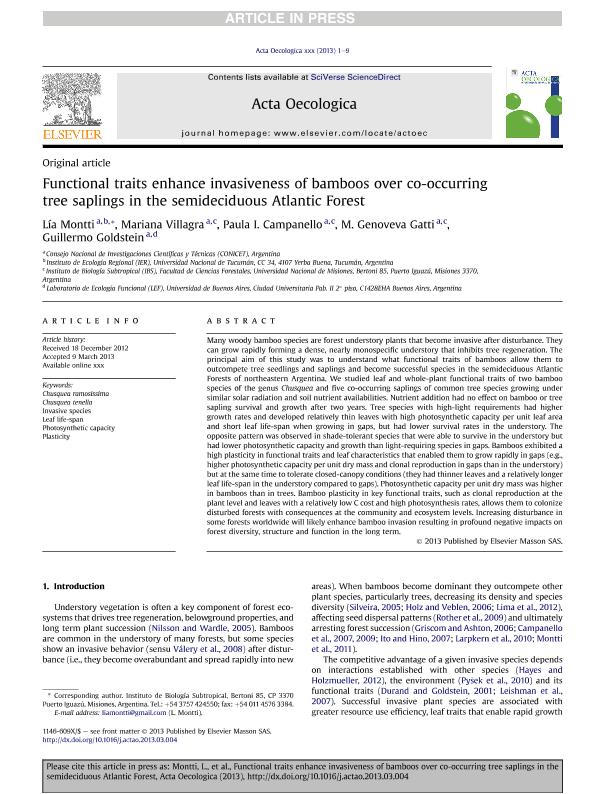Artículo
Functional traits enhance invasiveness of bamboos over co-occurring tree saplings in the Semideciduous Atlantic Forest
Montti, Lia Fernanda ; Villagra, Mariana
; Villagra, Mariana ; Campanello, Paula Inés
; Campanello, Paula Inés ; Gatti, Maria Genoveva
; Gatti, Maria Genoveva ; Goldstein, Guillermo Hernan
; Goldstein, Guillermo Hernan
 ; Villagra, Mariana
; Villagra, Mariana ; Campanello, Paula Inés
; Campanello, Paula Inés ; Gatti, Maria Genoveva
; Gatti, Maria Genoveva ; Goldstein, Guillermo Hernan
; Goldstein, Guillermo Hernan
Fecha de publicación:
03/2013
Editorial:
Elsevier
Revista:
Acta Oecologica
ISSN:
1146-609X
Idioma:
Inglés
Tipo de recurso:
Artículo publicado
Clasificación temática:
Resumen
Many woody bamboo species are forest understory plants that become invasive after disturbance. They can grow rapidly forming a dense, nearly monospecific understory that inhibits tree regeneration. The principal aim of this study was to understand what functional traits of bamboos allow them to outcompete tree seedlings and saplings and become successful species in the semideciduous Atlantic Forests of northeastern Argentina. We studied leaf and whole-plant functional traits of two bamboo species of the genus Chusquea and five co-occurring saplings of common tree species growing under similar solar radiation and soil nutrient availabilities. Nutrient addition had no effect on bamboo or tree sapling survival and growth after two years. Tree species with high-light requirements had higher growth rates and developed relatively thin leaves with high photosynthetic capacity per unit leaf area and short leaf life-span when growing in gaps, but had lower survival rates in the understory. The opposite pattern was observed in shade-tolerant species that were able to survive in the understory but had lower photosynthetic capacity and growth than light-requiring species in gaps. Bamboos exhibited a high plasticity in functional traits and leaf characteristics that enabled them to grow rapidly in gaps (e.g., higher photosynthetic capacity per unit dry mass and clonal reproduction in gaps than in the understory) but at the same time to tolerate closed-canopy conditions (they had thinner leaves and a relatively longer leaf life-span in the understory compared to gaps). Photosynthetic capacity per unit dry mass was higher in bamboos than in trees. Bamboo plasticity in key functional traits, such as clonal reproduction at the plant level and leaves with a relatively low C cost and high photosynthesis rates, allows them to colonize disturbed forests with consequences at the community and ecosystem levels. Increasing disturbance in some forests worldwide will likely enhance bamboo invasion resulting in profound negative impacts on forest diversity, structure and function in the long term.
Archivos asociados
Licencia
Identificadores
Colecciones
Articulos(CCT - NORDESTE)
Articulos de CTRO.CIENTIFICO TECNOL.CONICET - NORDESTE
Articulos de CTRO.CIENTIFICO TECNOL.CONICET - NORDESTE
Articulos(IBS)
Articulos de INSTITUTO DE BIOLOGIA SUBTROPICAL
Articulos de INSTITUTO DE BIOLOGIA SUBTROPICAL
Citación
Montti, Lia Fernanda; Villagra, Mariana; Campanello, Paula Inés; Gatti, Maria Genoveva; Goldstein, Guillermo Hernan; Functional traits enhance invasiveness of bamboos over co-occurring tree saplings in the Semideciduous Atlantic Forest; Elsevier; Acta Oecologica; 54; 3-2013; 36-44
Compartir
Altmétricas



